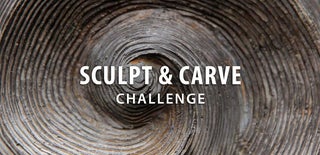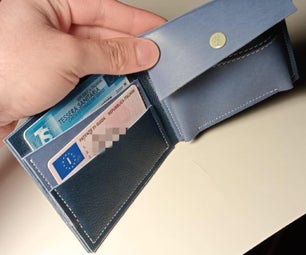Introduction: Strawberry Flower Pot Sculpted With Air Dry Clay
This fun strawberry flower pot can be used by fruit lovers to display plants, hold pens or brushes. Made with widely available air dry clay, there is no need to use a kiln. It is painted and varnished with regular art supplies and sculpted mainly with hands and homemade tools.
I made several of these planters over the year. Each time I sculpted it in one sitting, I listened to tips from sculptors and used fillers to reduce the overall weight of the sculpture. However, I always ended up with one major problem - wobbling. The main reason being the structure was too heavy at the top and too light at the bottom. To overcome this I finally started sculpting it "the wrong way" by adding fresh clay on top of dried one. In most cases, when working with air dry clay you can't connect wet clay with dry clay because it shrinks as it dries and newly added pieces simply pop off. In this case however, it wasn't a problem because I used clay slip to connect wet and dry pieces and new, wet clay was wrapped around dry clay, so there was no way it could have popped off. I started using this method to pay special attention to the bottom of the planter to make sure it was level. I took additional 3 days to add layer after layer of clay circles to create a tapered bottom and made sure to let it dry upside down. Once I counteracted the heavy weight of the top part with a large amount of clay at the bottom, I removed the wobbling problem completely. I also realise that I could have made the strawberry with less tapered bottom, but I was dead set on making a sculpture as closely resembling a whole strawberry as possible.
You will need:
- 1kg DAS white modelling clay (I used the entire pack)
- Tools - If you don’t have specialised sculpting tools, don’t fret, you can always improvise. Use bamboo chopsticks, disposable cutlery, popsicle sticks. For a dotting tool you can use a bead and skewer it with a sharpened chopstick. You will also need a rolling pin, but you can use an unopened can, glass bottle or a plastic pipe.
- Plastic cup, cling film
- Scalpel, craft knife
- Old or disposable brush
- Fine sand paper
- Red and yellow acrylic, enamel or spray-on paint
- Gloss varnish
- Fast acting, two part epoxy syringe (30ml)
- 3x6 mm rhinestones for seeds
Step 1: Plastic Cup & Clay Slip
I made this planter with a specific plant in mind, so I had to make sure it will fit once finished. To create a hole, I used a cup slightly larger and about 2cm taller than the planter and that’s done on purpose, so that the strawberry pot can be left to dry upside down. I marked that 2cm overhang with a sharpie so I wouldn't forget.
You don’t want to use a cup that’s too rigid, as you might have problems removing it from the strawberry once the clay sets. My cup was actually too flexible, so I had to temporarily stiffen the walls by filling it with rice all the way to the top and sealing the opening with tape.
Lastly, I covered the cup with cling film to ease the removal later on.
Prepare a small amount of clay slip. It will be used later on, but it takes time to dissolve. Take a grape-size amount of clay and rip it into small pieces, put in in a small container, add just enough water to cover the clay and put it aside. You might want to cover the container to keep the water from evaporating.
Step 2: Day 1
Roll the clay between 0.7 and 1.2cm thick and cut an appropriate shape to cover the walls. Make sure to leave 2cm space at the top. Seal the edges by pinching them and smooth roughly. This layer doesn't have to be pretty, we just want a hard outline of the cup.
Be extra careful to keep the clay smooth and level and cut out a circle to cover the bottom. Use a smoothing tool to connect the edges to the walls.
Leave it to dry upside down for 24 hours.
Step 3: Day 2
Gently pull the cup out. If it’s stuck, remove the rice and try bending it until you can slide it straight out.
Use a brush to dab a small amount of clay slip onto the seam cracks. Roll a thin roll of clay and push it in to cover the imperfections, scrape it with a tool and brush it with clay slip to keep it smooth. Fill in the wall cracks too.
Roll the clay to approximately 1cm thickness and cut a circle. Brush some clay slip onto the dried bottom, add fresh clay and gently connect the edges with the wall.
Leave it to dry for a few hours until the bottom feels leathery, you don't have to dry it for 24 hours this time.
Step 4: Day 2- Few Hours Later
Roll the clay to 1-1.5 cm thickness. Cut appropriate amount of clay to wrap around the top half of the pot. Smear clay slip over the top and middle part of the pot and cover the top part with clay. Blend it roughly and use your fingers to smooth it towards the middle. Use a tool to roughen the surface, which will help the fresh clay stick to the pot later on.
Cut another 1-1.5 cm circle, smear clay slip onto dried bottom and gently place the clay circle on top.
Leave it to dry for 24hours.
Step 5: Day 3
Since my planter wasn't tall enough, I added another 1.5 cm thick, smaller circle of clay to the bottom. I connected it with clay slip and let it dry for a further 24 hours.
Step 6: Day 4- Sculpting
I applied clay slip to the bottom part of the pot and started adding rolls of clay to bulk it up. Work with your fingers to press fresh clay onto the surface and create a relatively even surface.
Apply slip to the middle and add fresh clay to that part and smooth it roughly.
Finally, brush the top part of the planter with clay slip and add a thick layer of clay. Use your hands to connect and smooth all fresh clay pieces together. Check if you are satisfied with the shape, add more clay or remove portions of it if needed.
Step 7: Smoothing
Use a tool to smooth the entire surface or the pot. I used a plastic spoon with straight tip, but you can use a plastic, blunt knife, wooden stirring sticks or other tools.
I wanted the pot to have an irregular rim, so I used a scalpel to create cuts at the top part (picture 5). To smooth the irregularities, I used a smoothing tool and a brush dipped in clay slip.
Lastly, I used a small sponge (regular sponge for dishes) soaked in water and rubbed it all over the strawberry to smooth it as much as possible.
Step 8: Holes
I begun by removing small amounts of clay using a small loop tool, I then followed that with my home-made dotting tool (small bead glued to a piece of wood) to create smooth and oval holes.
I used a brush dipped in water or slip to aid me in smoothing the holes and fixing any mistakes I made.
Once I was satisfied with the details, I flipped the pot bottom up and let it dry for 24 hours.
Step 9: Fill & Sand
Remove the cup from the dried planter, brush clay slip onto any remaining cracks and rub small amount of clay to fill them in. Smooth and leave to dry.
This is the last drying period before painting, so make sure you leave it out for as long as it takes for clay to become bone-dry. Drying time depends on the type of clay you use and your environment (humidity, heat). It can take between 1 and 4 days.
Once fully dry, go over the whole pot with a fine sanding paper, smooth the seams, any imperfections and raised bumps. Use a dry nail brush to get rid of the dust before painting.
Step 10: Paint
I initially painted it with acrylic paint, but my red paint just wasn't vibrant enough, so I added a layer of red spray paint on top. It worked great, creating a uniform colour, shine and with minimum fuss. I also painted on the inside of the pot. Once dry, I used a small brush to paint the seed pits using darker red (almost brownish) to add some more depth.
Step 11: Epoxy Seal
This pot doesn't have any drainage, so water will gather inside. If exposed to water, dried, unsealed clay will become soft over time and disintegrate the planter. To make the pot waterproof I decided to use two part epoxy syringe to create a hard, impenetrable layer. I squirted 30ml of fast setting epoxy into the pot, mixed it well and used a disposable brush to spread it around the bottom and sides.
Step 12: Seeds
To create seeds, you can just paint them directly onto the surface with yellow paint, acrylic or enamel. I didn't have any opaque yellow at home, so instead I used rhinestones (3x6mm) I had on hand.
I covered a piece of paper with a thin layer of stick glue, spread the rhinestones all over the paper facing up and let the glue dry. I then spray painted the whole thing and once dry, I simply peeled them off.
Use a bamboo skewer and cover the blunt end with a bit of plasticine or something similar. To affix the seeds, pour a few drops of super glue onto waxed paper, aluminium foil or plastic, any surface where glue won't dry immediately. Pick a rhinestone with the skewer and drag it through a tiny amount of superglue, just enough for the back of it to get wet, not the entire rhinestone. Place the seed in a divot and apply light pressure for 5 seconds before moving to the next seed.
Step 13: Varnish
With a small, soft brush I applied glossy varnish to the seeds and left them covered as you can see in the picture to ensure the seeds won't un-stick. Once all seed pits are ''soaked'', I covered the rest of the planter in varnish (use a bigger brush) and let it dry.
To add more protection and even more gloss I decided to use spray-on acrylic sealer all over the planter. That's optional, but I wanted extra shine.
Step 14: Add Plants

Participated in the
Sculpt & Carve Challenge














5 Comments
2 years ago
This planter is adorable and so clever! Thank you for the very detailed instructions and photos!
2 years ago
I am amazed at your creativity. You picked the perfect plant to showcase your strawberry planter. It got me thinking of what plant would look good in other containers. A pineapple container would be interesting or a tomato with a spider plant? I see that I am not the only one who is upset at the fact that we are not able to vote. If we could, you would definitely get my vote.
2 years ago
Is Beautiful I love it ❤❤❤🌻🌻🌻
2 years ago
Again I really wanted to vote!
2 years ago
I love this as a planter and the way you did the seeds is great :)